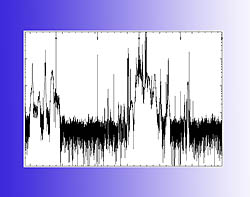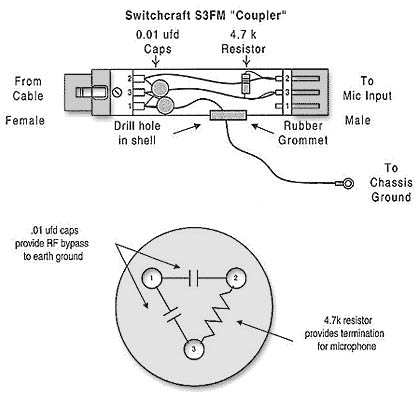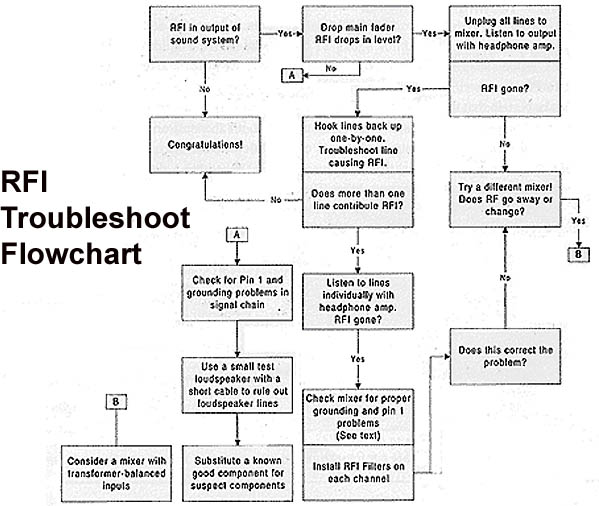
I keep a small, four channel unit for this purpose. It has transformer-balanced inputs and outputs and runs off of batteries which keep it isolated from the building AC and grounds.
If your mic lines still have RF when hooked-up to this mixer, your problem is getting more serious.
If the problem goes away, you will quickly learn why some mixers cost much more than others. Remember, it’s the stuff on the inside that counts.
Rule Out the Wire
Substitute a different mic line. I keep a 100-foot length of “star quad” cable for making acoustic measurements.
Substitute such a cable for your installed mic line. Just lay it out along the same path and hook the mic to it.
If the RFI goes away, you have learned why some wire costs more than others. In sensitive installations, this is a test that you’II want to perform before you spec the wire.
Filtering Out RFI
When all else fails, you may need to install some filters on input and output lines. These filters come in several forms.

The most readily available (and simplest) are ceramic disc capacitors. These are soldered from pins 2 and 3 to pin 1 (Figure 2).
The capacitor becomes a low-pass filter that provides a low impedance path for frequencies above its corner frequency to ground.
What is the correct value? A common one is 0.01 microfarads. Since the filtering characteristics are dependent upon the circuit impedance, the best thing to do is to start with a small value and increase it until the high-frequency roll-off becomes audible (broadband pink or white noise as a source).
A capacitor substitution box works well for this purpose. Be sure to use the same value on each pin. Sometimes it is necessary to achieve a steeper roll-off than a single capacitor can provide.
You can accomplish this by using a series inductor (or “choke”) along with the capacitor. These can be acquired at the local Radio Shack.
Ferrite beads are also useful as input filters. These can be slipped over a small length of bus wire and placed in series with the signal. RFI filters can get quite complex, and only some simple examples have been listed here.
Before you get too elaborate, make certain that you are not attempting to “cover-up” a design flaw in one of the sound system components.
The most practical way to fix such problems is to consult the manufacturer or substitute a different device for the one giving you headaches. Sometimes manufacturers are reluctant to admit that their product(s) have a problem, so prove it to yourself by the substitution method.
When you find yourself resorting to these kinds of methods, the best solution often is to install input transformers on the offending mic lines. Transformers offer the highest RFI immunity and RFI “blocking” capability of all methods discussed.
Their sole drawback is cost. Then again, if you are making your fifth trip back to a venue to troubleshoot RFI problems, transformers start to look quite economical!

It is rare, but not impossible, for RFI to get into the system after the mixer. Make certain that you isolate the problem to pre- or post-mixer immediately. This can save hours of troubleshooting.
RFI can be a major problem for system installers and designers. The measures contained herein represent ideas contributed by a large group of audio professionals, and should suffice in correcting most RFI problems that are not design flaws in signal processing equipment.
When in doubt as to a device’s RFI immunity, SUBSTITUTE A KNOWN-GOOD DEVICE.
One learns to appreciate very quickly the price and performance of professional-quality equipment in high-RFI environments.
